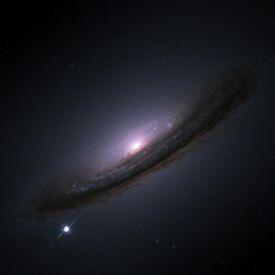Astronomy:SN 1994D
 Hubble Space Telescope image of SN 1994D, visible at lower left | |
| Event type | Supernova |
|---|---|
| Spectral class | Type Ia[1] |
| Date | March 7, 1994[2] |
| Constellation | Virgo |
| Right ascension | 12h 34m 02.395s[1] |
| Declination | +07° 42′ 05.70″[1] |
| Epoch | B2000.0 |
| Distance | 55.1 ± 5.2 Mly (16.9 ± 1.6 Mpc)[3] |
| Host | NGC 4526[2] |
| Progenitor type | White dwarf |
| Peak apparent magnitude | +15.2 |
| Preceded by | SN 1994C[4] |
| Followed by | SN 1994E[4] |
SN 1994D was a Type Ia supernova event in the outskirts of galaxy NGC 4526. It was offset by 9.0″ west and 7.8″ south of the galaxy center and positioned near a prominent dust lane.[1] It was caused by the explosion of a white dwarf star composed of carbon and oxygen.[5] This event was discovered on March 7, 1994 by R. R. Treffers and associates using the automated 30-inch telescope at Leuschner Observatory.[2] It reached peak visual brightness two weeks later on March 22.[5] Modelling of the light curve indicates the explosion would have been visible around March 3-4. A possible detection of helium in the spectrum was made by W. P. S. Meikle and associates in 1996.[1] A mass of 0.014 to 0.03 M☉ in helium would be needed to produce this feature.[6]
See also
References
- ↑ 1.0 1.1 1.2 1.3 1.4 Meikle, W. P. S. et al. (July 1996). "An early-time infrared and optical study of the Type IA supernovae SN 1994D and 1991T". Monthly Notices of the Royal Astronomical Society 281 (1): 263–280. doi:10.1093/mnras/281.1.263. Bibcode: 1996MNRAS.281..263M.
- ↑ 2.0 2.1 2.2 Treffers, R. R.; Filippenko, A. V.; van Dyk, S. D.; Richmond, M. W. et al. (1994). Green, D. W. E.. ed. "Supernova 1994D in NGC 4526". IAU Circular 5946: 2. Bibcode: 1994IAUC.5946....2T.
- ↑ Hatt, Dylan et al. (July 2018). "The Carnegie-Chicago Hubble Program. IV. The Distance to NGC 4424, NGC 4526, and NGC 4356 via the Tip of the Red Giant Branch". The Astrophysical Journal 861 (2): 10. doi:10.3847/1538-4357/aac9cc. 104. Bibcode: 2018ApJ...861..104H.
- ↑ 4.0 4.1 List of Supernovae, International Astronomical Union, http://www.cbat.eps.harvard.edu/lists/Supernovae.html, retrieved 2021-12-02.
- ↑ 5.0 5.1 Lentz, Eric J. et al. (August 2001). "Non-LTE Synthetic Spectral Fits to the Type Ia Supernova 1994D in NGC 4526". The Astrophysical Journal 557 (1): 266–278. doi:10.1086/322239. Bibcode: 2001ApJ...557..266L.
- ↑ Boyle, Aoife et al. (March 2017). "Helium in double-detonation models of type Ia supernovae". Astronomy & Astrophysics 599: 12. doi:10.1051/0004-6361/201629712. A46. Bibcode: 2017A&A...599A..46B.
Further reading
- Branch, David et al. (June 2005). "Comparative Direct Analysis of Type Ia Supernova Spectra. I. SN 1994D". The Publications of the Astronomical Society of the Pacific 117 (832): 545–552. doi:10.1086/430135. Bibcode: 2005PASP..117..545B.
External links
 |

